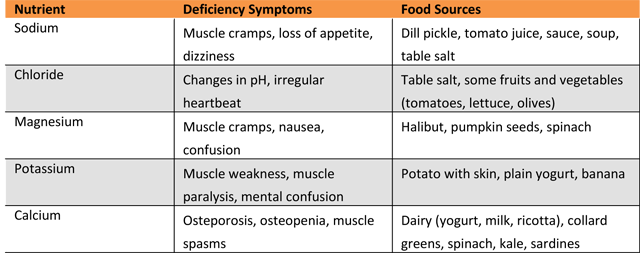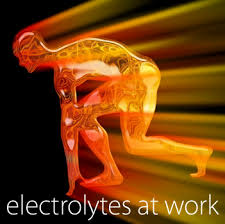Guest blog by LiveFit Head Trainer Rich Berrian:
Sodium, calcium, magnesium, and potassium… most of us have heard of these before… some of us know that these are good for you… but hardly any of us know that these four minerals are some of the most common electrolytes.

So what is an electrolyte anyway?
By definition:
“Electrolytes are minerals in your body that have an electric charge. They are in your blood, urine and body fluids. Maintaining the right balance of electrolytes helps your body’s blood chemistry, muscle action and other processes. Sodium, calcium, potassium, chlorine, phosphate and magnesium are all electrolytes”
Minerals, such as the ones listed above and below, are elements that are extracted from the soil and water and can’t be made by living organisms; thusly, why it is important that we acquire them from an outside source such as food, drinks, or vitamin/mineral supplements.
Sodium – helps to regulate blood pressure, aids in muscle contraction, assists with transmission of nerve signals, and helps to transport glucose and other nutrients. Too much sodium can lead to high blood pressure, bone loss, and kidney stones. Shockingly, bread is the biggest contributor of sodium to the general population’s diet because of how frequently it is consumed.
Calcium – is a major contributor to bones and teeth, aids in muscle contraction and nerve transmission, plays a role in cellular metabolism, and helps with blood clotting. Dairy products and some vegetables such as Chinese cabbage, kale, and turnip greens are valuable sources of calcium. Too much calcium may interfere with the absorption of magnesium, iron, and zinc in the body. On the flip side, not enough calcium can cause brittle bone which can lead to osteoporosis. Some research indicates that low levels of calcium may be linked to high blood pressure and colon cancer.
Magnesium – plays a huge role in assisting enzymes with more than 300 chemical reactions in the body, aids in muscle contraction, supports cellular activity, helps blood clotting, and is a component of bone. Leafy greens, potatoes, whole grains, nuts, seeds, and legumes are all great sources of magnesium. Excessive levels of magnesium may cause confusion, loss of kidney function, difficulty breathing, and cardiac arrest. Low levels of magnesium can cause loss of appetite and weakness, and may later result in irritability, confusion, and cardiac abnormalities.
Potassium – helps to manage blood pressure by blunting the effects of large amounts of sodium, assists in nerve transmission, and aids in muscle contraction. Foods such as fruits, vegetables, and dairy products are usually rich in this mineral. Potassium helps to balance sodium within the body, low potassium levels can be the cause of high blood pressure when sodium levels are excessive. However, excessive potassium levels ultimately can alter the rhythm of the heart resulting in heart attack and/or death. Research suggests that less than 3% of Americans meet the daily AI (adequate intake) for potassium.

So what have we learned? Each and every one of these common electrolytes aids in muscle contractions which is critical when exercising or being physically active. Without muscle contraction there is no movement of the body part you are trying to move.
Also, be sure to check the amounts of each electrolyte that you are consuming and what the daily AI is so that you don’t experience all the negative effects that come along with toxic levels of these minerals.
To demand the most of your body, you must know your body!
In Fitness and Health,
Richard Berrian
Personal Trainer
#gunslikerich




